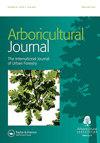Urban green infrastructure affects woody plant diversity and carbon stock in Hawassa city in Ethiopia
Q3 Agricultural and Biological Sciences
引用次数: 5
Abstract
ABSTRACT Urbanisation tends to alter the ecosystem. Urban green spaces are established to reduce impacts of urbanisation. However, in developing regions, this is often neglected. Hawassa city, Ethiopia, is greatly affected by rapid urbanisation. Hence, this study’s aim was to assess the role of green infrastructure in woody species diversity and carbon stock in Hawassa city. A cluster sampling methodwas used to classifythe existing green infrastructure. Two hundred and forty sample plots were used to compile a woody species inventory and for soil sampling. Fifty eight woody species belonging to 44 genera and 28 families were recorded; 67.25% of these were exotics. The highest Shannon–Wiener diversity was in private and public institution compounds (mean 1.35) and the least was street trees (0.68). The highest mean biomass carbon was recorded in street trees (167.5 t C ha−1) and the lowest in urban forest (11.4 t C ha−1). Soil organic carbon accounted for 90% of ecosystem carbon stocks for urban forest, 60% for private public institution, 57% for urban church forest and 37% for street trees. Generally, there is lower species diversity, a dominance of exotic species. Planting diverse and indigenous species should be the next priority.城市绿色基础设施影响埃塞俄比亚阿瓦萨市木本植物多样性和碳储量
城市化往往会改变生态系统。城市绿地的建立是为了减少城市化的影响。然而,在发展中地区,这一点往往被忽视。埃塞俄比亚的哈瓦萨市深受快速城市化的影响。因此,本研究的目的是评估绿色基础设施对哈瓦萨市木本物种多样性和碳储量的作用。采用聚类抽样方法对现有绿色基础设施进行分类。240个样地用于编制木本物种清单和土壤取样。记录到木本植物58种,隶属于28科44属;其中67.25%为外来品。Shannon-Wiener多样性最高的是公私机构群落(平均1.35),最低的是行道树(平均0.68)。平均生物量碳最高的是行道树(167.5 t C ha - 1),最低的是城市森林(11.4 t C ha - 1)。土壤有机碳占城市森林生态系统碳储量的90%,占公私机构生态系统碳储量的60%,占城市教堂森林生态系统碳储量的57%,占行道树生态系统碳储量的37%。总体上物种多样性较低,外来物种占优势。种植多样化和本地物种应该是下一个优先事项。
本文章由计算机程序翻译,如有差异,请以英文原文为准。
求助全文
约1分钟内获得全文
求助全文
来源期刊

Arboricultural Journal
Agricultural and Biological Sciences-Agronomy and Crop Science
CiteScore
2.40
自引率
0.00%
发文量
28
期刊介绍:
The Arboricultural Journal is published and issued free to members* of the Arboricultural Association. It contains valuable technical, research and scientific information about all aspects of arboriculture.
 求助内容:
求助内容: 应助结果提醒方式:
应助结果提醒方式:


